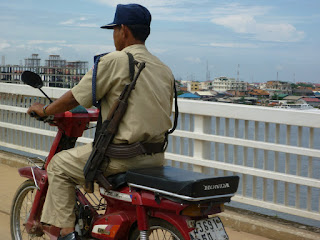



I just returned from a three-day weekend in Phnom Penh, Cambodia’s capital city. To see the city properly, you will only really require about two days, as much of the sites are clustered in one general area. On day one, Friday, having dropped off the bags at the simple but correct Paragon hotel (facing the Tonlé Sap river confluence, where much activity is occurring on the river’s edge), after being hassled, practically bombarded by Tuk Tuk drivers trying to negotiate a couple (or much more) bucks to take you to the Killing Fields, we settled for the smiley, cute-faced Tuk Tuk driver who hung out in our hotel lobby and seemed to be regular pals with the receptionists.
We originally settled on a fare of $15 to take us to the Killing Fields and Genocide Museum, feeling skeptical about the price we were told. Although only 15 km (about 9 miles) away from the capital, getting to the Killing Fields by Tuk Tuk was rather trying. Luckily, I have already spent one year in Bangkok; I have sat in various forms of transportation through Bangkok traffic and on upcountry roads, so I can more or less safely say that I am “acclimated” to the driving and traffic rules (which, may I add, are rather nonexistent) of Southeast Asia, however, nothing in Thailand could have prepared me for the kind of happenings on the road that took place in Phnom Penh. While crossing the road in the Tuk Tuk, the driver (from what I could tell, all drivers) paid no heed to pedestrians, other vehicles, or any other stationary objects in the road. Anything goes, really, and it seems like you can drive on sidewalks, too, if your vehicle permits. Cambodians seem to be car-horn (or Tuk-Tuk horn) friendly, applying the hand frequently, for no reason in particular, but just to signal that they are coming.
Despite the insanity taking place on the road, I was able to see a bit Phnom Penh and its outskirts relatively well via Tuk Tuk. I quite enjoyed the airflow that came through journeying by Tuk Tuk, although it didn’t manage to dry my soaking self off much. There are some lovely parts to the city, such as where the government offices are located, near the independence monument, and the street in front of the Grand Palace. Seeing the run-down colonial architecture brought a sense that there is a great amount of history to the place; although at times I felt as though the city is still caught up in its own history and has not yet had the opportunity to move forward.
Throughout my three days in the capital city, I daresay I’ve never seen more naked children running around. There were a huge amount of kids selling photocopied books in a basket around their neck, carrying baby ducks, looking for the smile of a foreign tourist and a few bucks; and a lot of desperation and hands reaching out to you like you have the solution, which you don’t, as the token tourist. Outside the Killing Fields, swarms of kids ran up to us begging for our plastic $1 raincoats, and they held on to the Tuk Tuk until it took off, leaving them behind and yourself with a sad feeling.
Other points of interest in Phnom Penh besides the harrowing Killing Fields include the Toul Sleng Genocide Museum, which features numerous head-shots of victims killed by the Khmer Rouge. If you don’t know much about this period in Cambodian history, books are readily available, although it might be wise to think twice before buying books from the children in the street as it is questionable who is profiting from this business.
The National Museum is also a nice stop-off place in Phnom Penh. The building itself is beautiful, built in 1917 under the inspiration of Khmer architecture. The museum is home to bits of Khmer history, including sculpture, bronzes, and religious relics. Just up the street and facing the wide river is the Foreign Correspondent’s Club of Cambodia (FCCC), a fantastic resting point that offers happy hour nightly from 5-7 pm and features tasteful red and white wines from Chile. They have a menu of Western and Khmer food, so why not try the ‘fish amok’, one of the more popular dishes you’ll see on the menus of the capital.
You could spend most of your day at the Foreign Correspondent’s Club, or any café on the quay, for that matter, cozied up with an iced coffee or an Angkor Beer, simply people-watching and soaking up so much of the culture. Life travels by as you sit and watch the Cambodian people who have so many stories to tell; so much history and have endured so much of life.
No comments:
Post a Comment